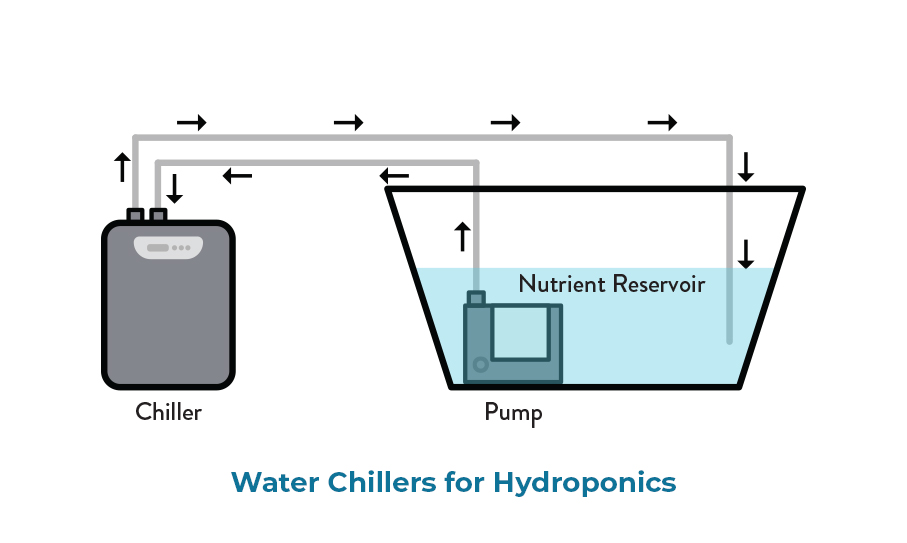Benefits of Water Chillers for Hydroponics - Temperature Control
By Hydro Experts | 22 October 2021

If you’re familiar with hydroponics, then you’ve probably heard of water chillers. But what are they, exactly? Water chillers are mechanical devices used to cool down the water in your hydroponic system; however, their impact goes far beyond simply keeping the water cold (although that’s definitely important!).
Here are the benefits of water chillers for hydroponics, whether you use an air or water-cooled chiller, and how to find one that fits your specific needs.
What Is A Hydroponic Reservoir Water Chiller?
A reservoir chiller is an in-line refrigeration device that is used to lower water temperature. The primary function of a water chiller in hydroponic systems is to reduce evaporation losses from within a large reservoir, thus reducing overhead costs and making more productive use of input energy.
These chillers are perfect for any operation that requires a constant supply of fresh, clean, and cold water at a lower temperature than ambient room temperature. Reducing evaporation will prevent contamination from happening within your system by reducing airborne pollutants from entering your reservoir.
Additionally, these units also help with algae control because you’re preventing them from growing inside of your tank. In addition to all of these benefits, you get even cooler temperatures throughout your root zone! Your roots will thank you once they’ve had some time under a blanket of cool air!
Why Should I Use A Water Chiller For Hydroponics?
To keep your plants healthy, you need to keep your temperature consistent. Most grow lights heat the room, so having a sound temperature control system is essential. The use of an air conditioner isn’t ideal because it will circulate humidity through your grow room, damaging your plants. Another reason you should use a water chiller for hydroponics is because some people believe it keeps all pests away from their crops.
Water chillers work by using water with your hydroponic nutrient solution and passing it through the water chiller unit. There are several brands available, with some being more effective than others. Although prices vary, they’re generally affordable and easy to use. If you have space, then one or two units can provide enough cooling in a small grow room, while three or four can be used in larger grow rooms if needed.
Another significant advantage is that water chillers don’t release excess heat, so they are relatively quiet, which is excellent news if you have a small grow room and, once installed, they require little maintenance. This makes them ideal for beginners and experienced growers who don’t want to worry about having to mess around with their system constantly.
What Are The Advantages Of Using A Water Chiller?
The summer months are always a busy time for horticulturalists. It’s not just because it’s an opportunity to get outdoors and enjoy some extra daylight hours. Many species have more significant growth spurts during these times, meaning that there’s an additional demand on your garden’s resources—and that includes water.
If you're growing plants hydroponically, you know just how important it is to be able to control both temperature and humidity levels inside your grow room—not only to maximize production but also to ensure plant health...all year round! However, it can be tricky to maintain proper conditions without heating or cooling systems in place. While air conditioners are effective at minimizing excess heat, they can be expensive.
Other Methods for Keeping your Hydroponics Reservoir Cool.
A few different methods you can use Use ice: Adding ice blocks or ice packs to your reservoir can help with cooling. Make sure that you add enough ice packs to keep temperatures low (roughly 15 degrees) and use them with care; if they become dislodged in any way, they could create serious safety hazards in your grow room. Also, consider that although adding more blocks of ice will help lower temperatures more quickly, they’ll also melt at a much faster rate.
The downside is that while adding ice to your reservoirs may be cheap, it requires frequent checks on water levels, which could cost you time and energy and money. Lastly, overuse of ice means that you’re sacrificing volume when growing plants directly in your hydroponic system. For many growers who don’t have ample space allowances, sacrificing volume is simply not an option.
Hydro Experts Recommended Water Chillers
Different types of chillers are available. Some are more suited to being used in grow rooms than others, so knowing what you need is essential when buying. Before buying a chiller, you should consider its flow rate, water pressure, noise levels and power consumption.
The flow rate tells you how much water it can move through per hour, while its pressure determines how quickly it can circulate water. It’s also helpful to think about if you want one that uses electricity or air conditioner coils instead - each option has pros and cons.
Noise level is an important thing to think about if your plant room is close to another part of your house because using a noisy chiller could be disruptive for other people in your household.







